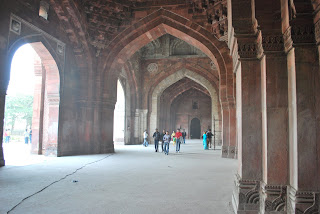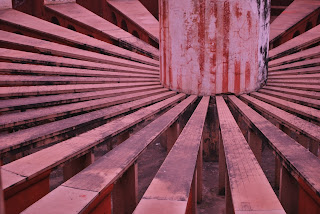




Gunung, or simply, ‘Mount’ Sibayak stands at just under 2100m and is one of two volcanoes above the town of Berastagi in the Karo Highlands to the south of Medan, where I was traveling from. The other volcano is Gunung Sinabung, which is another 400m higher. The volcanoes are the main attraction for most tourists coming to Berastagi, including me. It is a long time since I completed my geology degree and even longer since I was a kid fascinated by the books showing the power and visual attraction of these mountains, but I will always take a chance to visit them.
I didn’t notice until someone mentioned to me the following day that I had chosen to walk up Sibayak on Friday 13th, but not being superstitious it wouldn’t have affected my day had I known, touch wood.
Everyone I met had said just one thing, ‘Leave early’. I never actually asked why but I just assume that this is to get there before the afternoon clouds and rain drop over the mountain to rid you of a decent view of the crater and the views back over the town. So I duly set my alarm for 7.15am thinking that 8 or 8.30 is early enough for anyone, and must be what they meant by early.
At 7.15 I opened my eyes to darkness, but to be fair they were effective curtains. However on drawing them back I discovered it was indeed still dark, but with a streaky appearance and it was also somewhat louder than any weather should ever be. It was sheeting down. I decided a little too easily that another hour in bed was the decision of a wise man. Really, it was the judgement of a lazy one.
I eventually surfaced for breakfast at which point I chastised myself, whilst consuming my cold egg and barely toasted bread. In the UK I wouldn’t have put off a walk for rain, so why here? I knew I would be kicking myself later if the sun burst over the mountain at 11 then rained come the afternoon. No matter though, decision made, no rewind; and in any case the extra hour was quite welcome.
Leaving the hotel at 10am my second decision of the day was to walk all the way from my hotel rather than catch an opelet (minbus) up to the entrance to the mountain road. My thought process for this, if there was any, escapes me but it did add about three miles or so to my walk.
As ever though walking around gets you closer to the people and the streets (or fields) than being in a vehicle, so it was a chance to take a good look and get a feel for the area. The highlands here benefit from the rich soils and temperate climate thanks to the volcano and the elevation. It is very much the market garden for Sumatra and exports fruit, veg and livestock to Malaysia and Singapore. Some of the fields have a nice English feel to them, being planted with tomatoes, potatoes, spring onion and carrots, but these are juxtaposed with orchards of orange and fields of coffee and chilli, so not quite Ormskirk.
Within these fields or on plots immediately adjacent to houses were small burial plots evidently for individual families. These tended to have just two or three above ground burials which were surrounded by brick walls and variously painted or covered in glazed tiles. They are all Christian burials with some having large catholic images of Jesus or his mum, others don’t have anything but a simple cross (I expect these are probably the less showy protestants then). Some of these plots are remarkably kitsch, and I saw one which had a full sized painted statue of one of the occupants next to his coffin (I assume), he was resplendent in a neat grey suit and a rather eerie smile. While the area is home to the Bataks, who are largely Christian, at night with the curtains closed it doesn’t sound it with all the competing loudspeakers of the various small mosques dotted around the town – not sure if it was going on longer with it being the start of Ramadan or not, but it was an unholy racket (I know, sorry not PC).
Getting back to the burial plots I assume that this is a throwback to the culture of the Batak, rather than because the churches don’t have the real estate for cemeteries. The people here were of course animist prior to Christians coming here with the tidings that the silly sausages had been praying to the wrong gods for generations. While they are well and truly Christian now with both catholic and protestant churches aplenty the people do hedge their bets and still keep animist symbols such as water buffalo horns or sculptured heads of them on the top of the house, to guard over them. If there are serious concerns they will talk to their pastor or priest then go and have a word with their local shaman too. As long as one of them delivers then it is no doubt worth that extra bit of effort.
Umm, I was going for a walk before I transgressed wasn’t I….. so, once I had passed out through the north west edge of town and the fields I took a left up to the registration office for the walk up Sibayak. Here you sign an entrance book, so they can match a name to the body or something. Well, not really but they do not tire of telling you that people have died or gone missing for days on the mountain here, to some extent this is designed to get you to hire a local guide. Mind you I say that a little lightly, if you are going up any route other than the road up (which I was taking) then a guide probably is essential. As well as filling in the book you pay the princely sum of 1500 rupiah entrance fee (all of 11p).
A couple left up the road as I signed in, and I saw from the book that they are from the Netherlands. I am told later that up to 80% of the tourists in Sumatra are Dutch, while it seems a tad high, I have met an awful lot over here and it is certainly in excess of 50%. Indonesia is a former Dutch colony, and I am not sure but there may be more Dutch here now than when it was a colony.
After parting with a couple of ropey 1000 rupiah notes I start on up the tarmac road, with the couple in sight ahead of me; for a while at least. I soon begin to take breathers, masked as water or photo stops – not quite ‘head in hand, what am I doing here’ stops. The Dutch couple from then on are glimpsed infrequently ahead of me on the occasional long straights.
Walking on my own seems easier than walking accompanied – for I am not feeling like I am slowing anyone down or bothered that I am panting like an old dog in the summer sun within 5 minutes of walking up a shallow incline. I suppose both of those mean I am not worried about embarrassment. Still you need to motivate yourself to continue, while your other self is saying ‘look you’ve given it a go, no shame in stopping now’, or ‘who’s to know?’. On Sibayak though the motivation was that it was an active volcano, and ended the walk 40 minutes shy of the smoking vents, crater lake and sulphur deposits would be a poor second, and as Shanks said, ‘second is nowhere’.
The worst thing about this particular walk is that there are far too many ‘downs’ on the way up the mountain. As far as I am concerned there should be no downs in a hill walk until coming back from the top, any earlier dips can only mean steeper climbs later and even worse the niggling knowledge that on the way back down the mountain there were going to be some ‘ups’ to negotiate. It is patently wrong and it drew a few curses from me whenever I turned a corner to see a steep slope downhill on the outward leg.
Anyway I persevered and despite declining distances between ‘photo’ stops I got closer to the top. At one point I met an English girl coming down by herself and asked how far, and she indicated about an hour. This I felt was not the best of news, as I had thought it would be about 40mins. But I got on with it and it was only a couple more turns before it was the end of the road, at a ridiculously large car park, where the road ends. Here you have to scramble up a 5m white cliff of ash to reach the path above and the last leg of the climb. The path evidently used to comprise concrete steps all the way to the top, but now comprises occasional patches of concrete and some good water filled holes – all the more fun to negotiate. Two more stops for ‘photos and water’ and I was within sight of the steaming vents at the top of Sibayak and shortly after the distinctive bad egg smell of the hydrogen sulphide wrinkled my nose. The climb here was both more gentle and easier because the end was finally in sight.
As the guidebook says, it is everything you want and expect in a volcano, with numerous vents on all sides busily steaming away and the yellow stains of the sulphur deposits, there is even a small but perfectly formed crater lake. The only thing missing is lava, but to be fair if you were seeing lava on a strato volcano like this then facing the walk back would be the least of your worries.
As I sat above the crater lake a few guys and gals from Medan were setting up a camp in a hurry as the clouds came down and the rain began. Thanks to my lie in I had timed my walk to perfection. Fifteen minutes of clear viewing and then time to put away the camera. I then saw the Dutch couple for the first time in an hour and a half making their way down. On my descent I caught up with them and we had a good chin wag about the usual – where you going, where you been, what’s been best, where to avoid, etc. They turned off left at the junction to go to the hot springs on the other side of the mountain, while I continued on the return leg, to face the known ups and downs.
The rain which had been off and on all through the walk turned to a new setting: torrential and constant. Despite my hardy poncho I was soaked through and resigned to it; I think the water must have wicked up my sodden trousers! The walk had taken five hours door to door, and when I got back to the hotel bedraggled, very much in the style of a drowned rat, I was in dire need of a warm shower. Needless to say after ten minutes of staring at the ceiling and recovering on my lovely bed I staggered in to the bathroom to find that there was no warm water for a shower. But if that was the worst that Friday 13th could bring me, well then life is great!
















.JPG)
.JPG)














